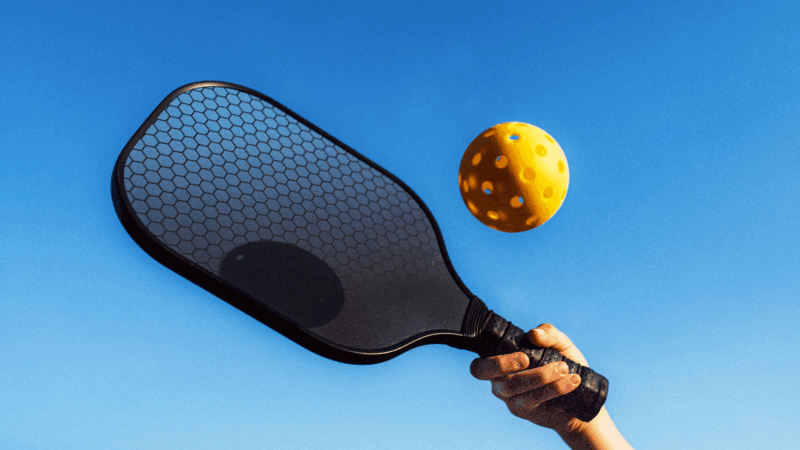Grab the goggles. Pickleball eye injuries are on the rise
Pickleball has quickly become huge in the United States, with nearly 20 million people playing the sport.
But that popularity comes with a price. With more people on the court, pickleball-related eye injuries, including lacerations around the eye, corneal abrasions and inflamed irises, have increased. A study published this week in JAMA Ophthalmology estimates that the incidence of these injuries has risen dramatically, going up by an estimated 405 cases each year from 2021 to 2024.
Researchers looked at data from a representative population of patients in emergency departments across the U.S. to understand which pickleball players are especially vulnerable to eye injuries and how they occurred. From there, they estimated what those trends looked like on a national scale.
Given the “alarming” increase in eye injury cases, the study authors called for developing standardized guidelines for eye protection, which has been found to reduce up to 90% of sports-related eye injuries. Other sports such as squash have mandated such guidelines.
The study found that 70% of cases were in adults 50 years or older. Dr. Natasha Desai, the co-director for the Center for Women’s Sports Medicine at NYU Langone, was surprised to see this finding because a large share of sports-related injuries occur in young players.
Desai, who wasn’t involved in this study, doesn’t think the sport is necessarily getting more dangerous. “More people are playing, so there’s going to be more injuries at a higher volume,” she says.
And there are a lot of ways you can get injured in pickleball, notes Dr. Corey Lacher, an ophthalmologist resident at Rutgers New Jersey Medical School and the paper’s lead author, including getting hit by the ball, a paddle or by falling.
“A lot of people think that just because it’s a wiffle ball that you’re not going to get hurt,” he says. But, it’s still risky because “everything is very fast-paced in pickleball and you’re playing on a very small court.”
However, getting players to wear eye protection is easier said than done, as Desai points out. It’s another piece of equipment players have to purchase and bring with them. And with so many options on the market, choosing a pair can be daunting.
Players would benefit from standardized eye protection guidelines for pickleball, says Lacher. “There’s $10 pickleball eye protection and there’s $160. How do you know which one to buy?”
If you’re shopping for eyewear, Lacher and Desai recommend products made of shatter-resistant polycarbonate and those that meet the American Society for Testing and Materials’s F3164 standard.
Dr. Daniel Henick, an ophthalmology resident at Yale School of Medicine and an avid pickleball player, has been researching which groups of players are wearing eye protection and why the rest aren’t. He says one of the most common reasons players don’t use protective eyewear is that they aren’t aware of the risks.
Henick says that having standardized guidelines, posting them outside of courts for players to see, making eye-protection more user-friendly, and encouraging professional pickleball athletes to set an example for the influx of new players could help reduce injuries.
The paper points out its limitations are having a small sample size and relying on a database that only includes emergency departments that opt in to the data collection. But Lacher sees the main takeaway from the study as bringing awareness to these injuries.
Henick agrees, noting these injuries can sometimes be life-changing: “We’re talking about hundreds, if not thousands, of injuries every year that could be prevented with what could be a relatively simple intervention.”
USA Pickleball did not reply to a request for comment on the study’s call for eye-protection guidelines.
Auburn tabs USF’s Alex Golesh as its next coach, replacing Hugh Freeze on the Plains
The 41-year-old Golesh, who was born in Russia and moved to the United State at age 7, is signing a six-year contract that averages more than $7 million annually to replace Hugh Freeze. Freeze was fired in early November after failing to fix Auburn’s offensive issues in three seasons on the Plains.
Alabama Power seeks to delay rate hike for new gas plant amid outcry
The state’s largest utility has proposed delaying the rate increase from its purchase of a $622 million natural gas plant until 2028.
Former U.S. Sen. Doug Jones announces run for Alabama governor
Jones announced his campaign Monday afternoon, hours after filing campaign paperwork with the Secretary of State's Office. His gubernatorial bid could set up a rematch with U.S. Sen. Tommy Tuberville, the Republican who defeated Jones in 2020 and is now running for governor.
Scorching Saturdays: The rising heat threat inside football stadiums
Excessive heat and more frequent medical incidents in Southern college football stadiums could be a warning sign for universities across the country.
The Gulf States Newsroom is hiring an Audio Editor
The Gulf States Newsroom is hiring an Audio Editor to join our award-winning team covering important regional stories across Mississippi, Alabama and Louisiana.
Judge orders new Alabama Senate map after ruling found racial gerrymandering
U.S. District Judge Anna Manasco, appointed by President Donald Trump during his first term, issued the ruling Monday putting a new court-selected map in place for the 2026 and 2030 elections.









